Changing Practice in Shoulder Dystocia: A Midwife’s Journey
Lesley Ansell – Midwife working in Central Auckland
Judith McAra-Couper – Lead Midwifery Department, AUT
Peter Larmer – Head of School, Clinical Sciences, AUT
Published in The Practising Midwife Volume 23 Issue 8 September 2020 https://doi.org/10.55975/EWWZ2758
Summary
Shoulder dystocia is a life-threatening childbirth emergency that has been recognised by midwives and obstetricians for centuries. When Lesley Ansell experienced a severe shoulder dystocia that resulted in the fracture of the fetal humerus, she knew there needed to be a change in practice. Here, she charts the journey that led her to discuss, investigate and research the notion of axillary traction as a method of resolving shoulder dystocia.
Background
Shoulder dystocia is a childbirth emergency that can result in significant maternal and neonatal trauma, and even neonatal death. Shoulder dystocia is defined as failure of the anterior, posterior or both fetal shoulders to enter the pelvic cavity following the vaginal birth of the fetal head.1 This potentially life-threatening emergency is one of the most alarming problems midwives face, but the relative rarity of shoulder dystocia means there is little opportunity to become ‘expert’ in dealing with the problem.1
This article presents my personal and research journey, which led to a change in practice when presented with shoulder dystocia. This journey led to the recommendation and subsequent adoption into practice that axillary traction be the first internal manoeuvre attempted when shoulder dystocia occurs. This change in practice is presented along with an explanation of how to ‘do’ axillary traction, that builds on our previously published article ‘Success rates of shoulder dystocia managed by internal rotational manoeuvres and delivery of the posterior arm: a review of the literature’.2
The journey
I witnessed a severe shoulder dystocia where the failure of the McRoberts, suprapubic pressure, internal rotational manoeuvres and then an attempt at delivery of the posterior arm resulted in a complete fracture of the humerus. The baby was born by literally being ‘dragged’ out by the broken arm and required full resuscitation. Following this traumatic experience, I spent many hours reflecting on the events of that birth. I thought about the attempt at delivery of the posterior arm and the shock I felt when I heard the humerus fracture. The midwife who eventually delivered the baby explained the difficulty she had in trying to locate the fetal elbow because both fetal shoulders had remained above the pelvic brim. In trying to locate the elbow she only managed to grasp the upper arm and the subsequent traction against the arm had caused the fracture. The traction had caused some movement in the shoulder and so she continued to pull on the damaged arm until the shoulder eventually descended below the pelvic brim and she was able to pull the baby through the pelvis.
I asked her why she didn’t grasp the fetal shoulder and use that to pull the baby down (my thought had been that if any child was trapped anywhere the natural reaction is to secure the child under their armpits to attempt to pull them free). Her response was ‘that’s not what we are taught’. That was fair comment – it was not what we were taught. I began to question what I would do if I was in the same situation again. It was evident that the manoeuvres we had been taught in our emergency skills days had failed in this situation and I realised the enormity of the practice problem we were facing.
Discussion with colleagues and the start of the research journey

I began to discuss management of shoulder dystocia with other colleagues, and a number had been in similar situations with the failure of the internal rotational manoeuvres and delivery of the posterior arm. I reflected on the need to move the fetal shoulders through the pelvis. This made me think more about the possibility of using the fetal axilla but in a way that would secure the arm firmly against the body so to prevent traction being applied to the humerus, which could result in a fracture. Traction could then be driven through the fetal axilla to move the shoulder through the pelvis. Also, it seemed reasonable that if a hand is placed into the pelvic cavity the fetal shoulder is located first before the fetal elbow. I began to question why we would bypass the axilla, which is a more accessible and tangible place to secure the fetus, and then apply traction to move the shoulder through the pelvis?
I researched the management of shoulder dystocia and found that the literature promoted the HELPERR mnemonic and the internal rotational manoeuvres of Rubins’ II, Woods’ screw or delivery of the posterior arm.3 I also investigated the mechanism of normal birth of the shoulders. Once the fetal head is born, the shoulders enter the pelvic cavity through the pelvic brim in the oblique or transverse diameter (the larger diameters at the inlet). The shoulders then rotate to the antero-posterior (A-P) diameter of the pelvis and the anterior shoulder lies behind the symphysis pubis. Restitution occurs whereby the fetal head externally rotates and the shoulders rotate forwards in the pelvic cavity.4 This enables the shoulders to be born with the bisacromial diameter in the A-P diameter of the pelvic outlet.5 Delivery of the shoulders is therefore facilitated by making use of the widest diameter at the outlet. The pubic arch acts as a ‘pivot’ for the anterior shoulder and the posterior shoulder is born first.6 Literature from the early 1990s supports that if birth is allowed to progress normally and unassisted, the posterior shoulder in most cases is spontaneously born first.7 Using this principle, it seemed reasonable that locating and grasping the posterior shoulder and applying traction to bring it down through the pelvis (while the anterior shoulder pivots around the symphysis in the same way as normal birth) could achieve birth during shoulder dystocia.
I began work as a Clinical Midwifery Educator at Auckland University of Technology (AUT) and during that time there were many discussions about the management of shoulder dystocia. These discussions often included the use of a doll and pelvis with demonstrations of how to ‘do’ axillary traction. As a result, I was encouraged to investigate the viability of axillary traction as a method of resolving shoulder dystocia. Subsequently shoulder dystocia became the subject of my master’s in Health Science Degree (MHSc) at AUT. This study,8 identified the difficulties practitioners had with both remembering and performing the internal manoeuvres described in HELPERR as well as their lack of effectiveness at times. When attempting the internal rotational manoeuvres, practitioners – without being aware – had often used axillary traction by ‘accident’, with success in resolving the shoulder dystocia.
Axillary traction in practice
During the course of the master’s study, other clinicians I worked with became aware of axillary traction and had witnessed traction being used with a good deal of success. They requested to be taught the manoeuvre and began to use it themselves in practice, again with a good degree of success. Axillary traction began to ‘creep’ into practice. The Senior Medical Officers (SMOs), Resident Medical Officers (RMOs) and midwives working in the area embraced the use of axillary traction. Frequently clinicians would contact me to tell me they had used it and how effective it was. As a result, the method of axillary traction for managing shoulder dystocia was reviewed by the Obstetric Quality Forum at Counties Manukau Health (CMH) (Auckland New Zealand) in 2009 and a new guideline including axillary traction was approved. As a result of that guideline, axillary traction was also included in the Practical Obstetrical Multi-Professional Training (PROMPT) emergency skills and drills training courses.
The original guideline only included a description of how to perform axillary traction but the most recent updated version (2018) includes photographs to assist with the description. The following is an excerpt from the 2018 guideline showing how to ‘do’ axillary traction:
Axillary traction
- Slide hand along fetal neck POSTERIORLY to shoulder
- Grasp posterior shoulder with thumb and first finger
- Place second finger on top of arm and hold down firmly
- Apply axillary traction to follow the curve of the sacrum. The anterior fetal shoulder will ‘pivot’ around the symphysis pubis and the posterior shoulder will be delivered first.
- The degree of traction required may be very significant. Applying traction through the axilla only and not against the fetal arm is unlikely to cause injury.
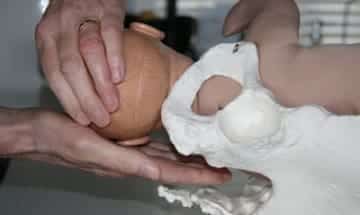
Slide hand along fetal neck posteriorly to shoulder
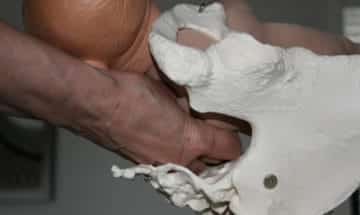
Grasp posterior shoulder with thumb and first finger
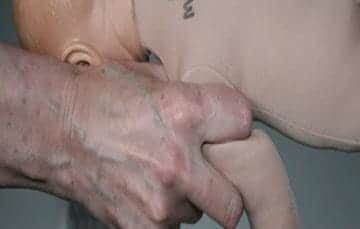
Place second finger on top of arm
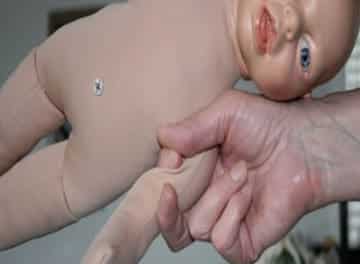
Apply axillary traction to follow the curve of the sacrum
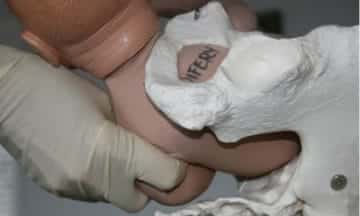
Anterior shoulder ‘pivots’ around the symphysis pubis – the posterior shoulder is delivered first
Document ID: A2794 Version: 4.0
Department: Obstetric and Gynaecology
Last Updated: 8/03/2018
Document Owner: Clinical Leader
Obstetrics Next Review Date: 8/03/2021
Approved by: Women Health Controlled Documents Group
Date First Issued: 01/02/2004
Counties Manukau Health
Spreading the word
The word about the use of axillary traction began to spread. In September 2010, I presented at the New Zealand College of Midwives 11th Biennial National Conference highlighting axillary traction ‘as an alternative and effective strategy for the management of this obstetric emergency…’
The session was extremely well attended, and I began to receive requests from midwives and midwifery educators for the shoulder dystocia PowerPoint presentation to be used as a teaching resource in midwifery schools throughout New Zealand. The presentation was repeated at Waitakere Hospital (Auckland New Zealand) the following month at the request of the midwifery clinical educators. An application to the New Zealand College of Midwives (NZCOM) to have axillary traction included in the mandatory clinical skills training programme for midwives was, however, declined in 2010 (anonymous, personal communication, Feb 1, 2010) on the basis that the manoeuvre had not been evaluated. Further research on my part led me to realise that the internal rotational manoeuvres (Rubins’ II, Woods’ screw) or delivery of the posterior arm had not been objectively evaluated either,9 but despite this, these manoeuvres were still being taught in New Zealand.
In 2012 the findings of the qualitative study for management of shoulder dystocia by axillary traction was published in Midwifery.8 Following that publication, I was approached by more midwifery educators and managers from several District Health Boards in New Zealand who wanted to include it in their shoulder dystocia guidelines and emergency skills training days.
As a result of the anecdotal success of axillary traction, I was approached by the Pacific Women’s Health Unit at Auckland University to write a chapter on the management of shoulder dystocia, including the use of axillary traction for the Pacific Emergency Maternal and Neonatal Training Manual. I have received feedback that axillary traction had been used a number of times in the Pacific islands with a great deal of success.
The word continued to spread. Student midwives, new staff midwives and Resident Medical Officers had heard about the manoeuvre and would approach me to teach them ‘how do it’. Many hours have been spent in the clinical area with a doll and pelvis with clinicians learning and practicing the manoeuvre. Often it was referred to as ‘Lesley’s’ manoeuvre’ and if a shoulder dystocia had occurred there were discussions around whether ‘Lesley’s’ manoeuvre’ had been used and if it had worked. On virtually every occasion, it seemed to have worked and if it had not worked for one clinician, then it usually did so if another clinician who was more experienced with the use of axillary traction took over.
Anecdotal evidence to research
As the anecdotal success of axillary traction grew, it became clear we needed further research to prove that axillary traction was effective in resolving shoulder dystocia. In 2014 I decided to undertake research to examine the success rates of the manoeuvres used to resolve shoulder dystocia. Axillary traction had been ‘introduced’ in 2009, so I decided to review the pre- and post-axillary traction years. I applied to the hospital research department for permission to conduct an audit of births complicated by shoulder dystocia from 2006 (three years before introduction) and 2012 (three years after introduction) to see if there was any evidence to support the use of axillary traction. Permission was granted by the hospital research department to undertake the study. Ethics approval was sought and granted by Southern Health and Disability Ethics Committee (reference: 14/STH/15) and shoulder dystocia became the subject of my doctoral work.
The doctoral study investigated the effectiveness of axillary traction when shoulder dystocia occurs. This retrospective review of internal manoeuvres used in the management of shoulder dystocia is the first to document the use of axillary traction for a large number of women. Of the 422 women who experienced shoulder dystocia, a total of 226 required internal manoeuvres to resolve the problem (53.6%). The first internal manoeuvres used were classified as axillary traction, posterior arm delivery or internal rotational manoeuvres.
The results of the study demonstrated a highly significant difference (p <0.001) in the success rates of the first used internal manoeuvres. In 52.7% cases the first internal manoeuvre used was axillary traction, which was successful in 95.8% of cases and no further manoeuvres were required. The success rate of axillary traction as a first internal manoeuvre was significantly greater than that for rotational manoeuvres (p <0.001) and posterior arm delivery (p 0.025).9 We presented the results of the study at the Royal Australia and New Zealand College of Obstetricians and Gynaecologists Conference in Brisbane in 2018.
Sharing practice knowledge
Although this has been my journey, to date it has not yet been officially endorsed within the wider maternity community in New Zealand. In order to share this knowledge as widely as possible I have created a YouTube video, which outlines how to do axillary traction. The video can be found using the following link: https://youtu.be/F1FVAcUwOXY.
Conclusion
Shoulder dystocia is a life-threatening complication of childbirth, which has been recognised by midwives and obstetricians for centuries. My own personal experience led me to discuss, investigate and research the notion of axillary traction as a method of resolving shoulder dystocia. The results of both anecdotal and research evidence have demonstrated the effectiveness of axillary traction for the resolution of shoulder dystocia. Axillary traction therefore should be the first manoeuvre used when an internal manoeuvre is required to resolve shoulder dystocia. TPM
References
- Gherman R. Shoulder Dystocia: an Evidence Based Evaluation of the Obstetric Nightmare. Clinical Obstetrics & Gynecology 2002;45(2):345-362.
- Ansell L, McAra-Coupler J, Larmer P. Success rates of shoulder dystocia managed by internal rotational manoeuvres and delivery of the posterior arm: a review of the literature. The Practising Midwife. 2020;23(5): 41-47 (online).
- Royal College of Obstetricians & Gynaecologists (RCOG). Shoulder Dystocia. Guideline No. 42. London: RCOG; 2012.
- Sleep J. Physiology and management of the second stage of labour. In: Bennet V, Brown L, eds. Myles textbook for midwives. 12th edition. Edinburgh: Churchill Livingstone; 1993.
- McEwan A, Johnson I. The problem of shoulder dystocia. Current Obstetrics & Gynaecology. 2004;14(1):62-67.
- Sutton J, Scott P. Understanding and Teaching Optimal Fetal Positioning. 2nd edition. Tauranga: Birth Concepts; 1996.
- Williams J. Obstetrics: A textbook for the use of student and practitioners. 2nd edition. London: Sidney Appleton; 1908.
- Ansell (Irving) L, McAra-Couper J, Smythe E. Shoulder dystocia: a qualitative exploration of what works. Midwifery. 2012;28:461-468.
- Gurewitsch E, Kim E, Yang B, Outland K, McDonald M, Allen R. Comparing McRoberts’ and Rubin’s manoeuvers for initial management of shoulder dystocia: An objective evaluation. American Journal of Obstetrics and Gynecology. 2005;192(1):153-160.
- Ansell L, Ansell D, McAra-Couper J, Larmer P, Garrett N. Axillary traction: An effective method of resolving shoulder dystocia. 2019 Oct;59(5):627-633.









